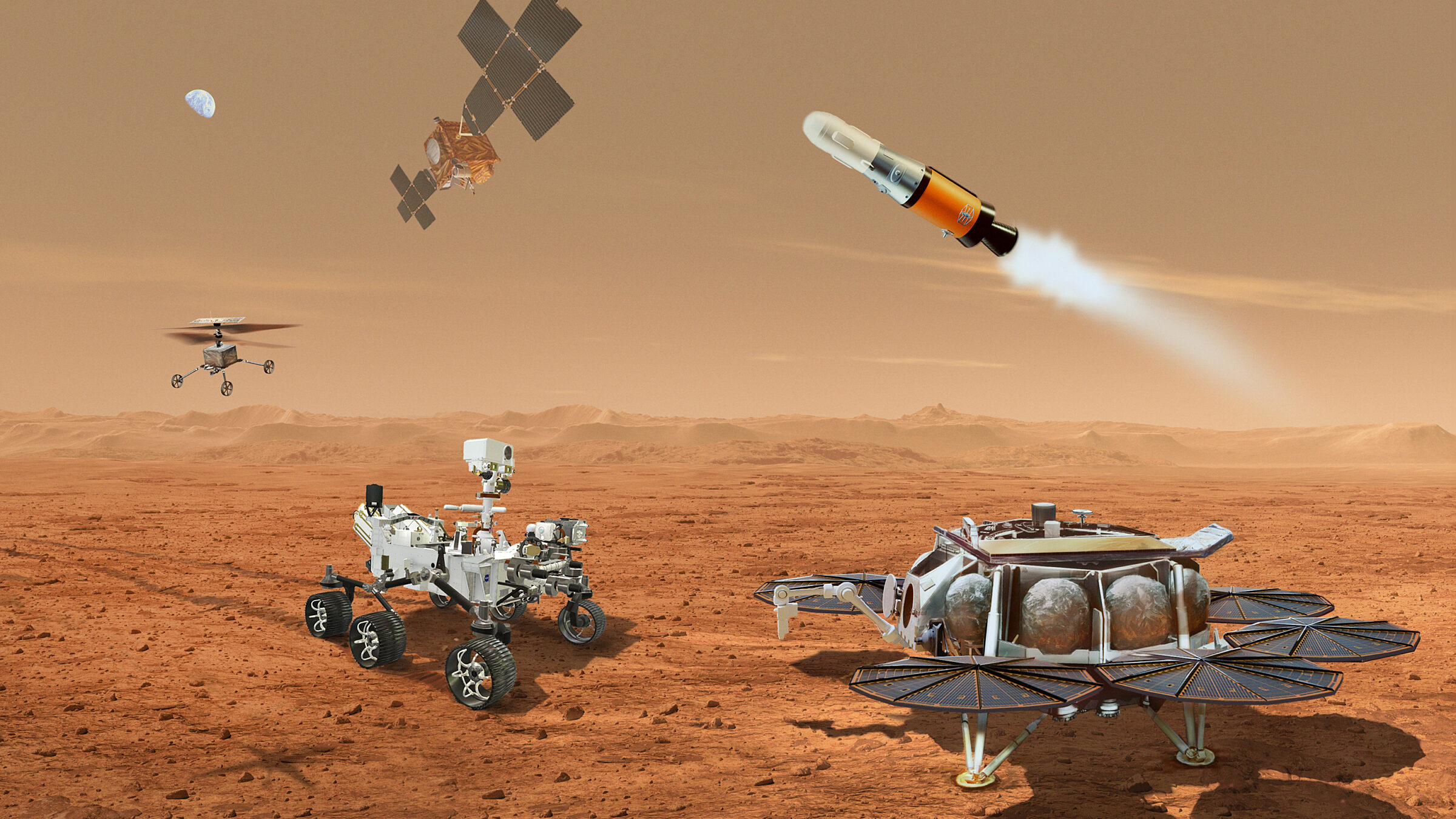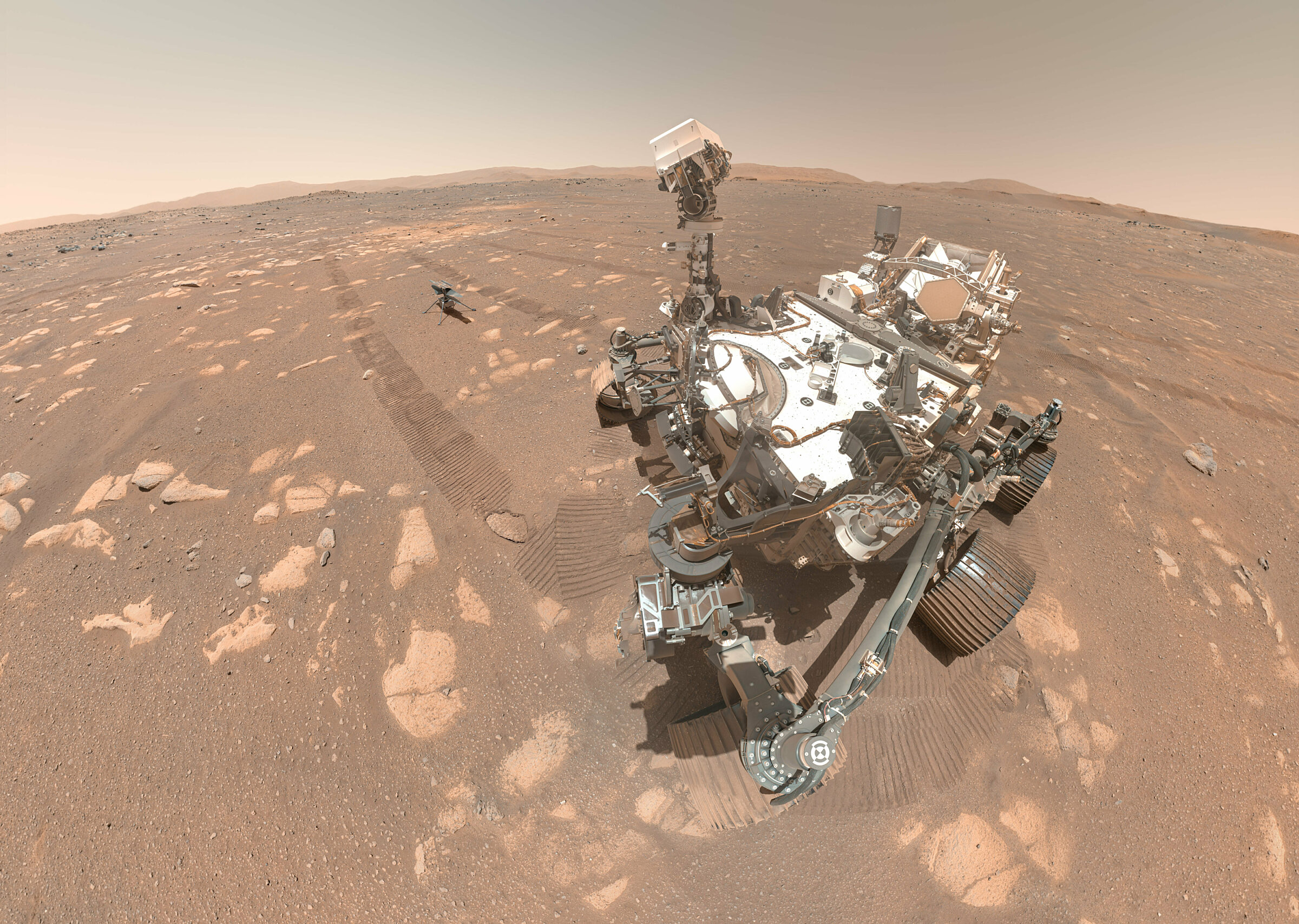Jamie Carter • Aug 23, 2022
How NASA will use helicopters to return samples from Mars in 2033
Astrobiologists might get their hands on the first samples from an alien planet in 2033. The plan: a capsule containing Martian rocks and soil would land in a desert west of Salt Lake City, Utah, striking the ground at 145 kilometers per hour (90 miles per hour).
The first-ever two-way trip to any planet, Mars Sample Return (MSR) is a unique mission being planned by NASA and the European Space Agency (ESA) to pick up rock samples collected by the Perseverance rover and bring them to Earth.
The scientific opportunity is huge, giving researchers the opportunity to thoroughly examine Martian rocks in Earth-based laboratories to look for signs of ancient life. Equally huge is the challenge of returning rocks from up to 400 million kilometers away (about 250 million miles).
NASA and ESA recently announced major updates to the mission, making it less expensive and arguably more exciting. Thanks to Perseverance's impressive performance, they were able to cancel the development of a new rover, giving Perseverance the role of fetching samples instead. The agencies also revealed that two Mars helicopters, based on NASA’s Ingenuity spacecraft, would assist with fetching samples.

The mass problem
In the original, ESA expected to send a rover to Mars to fetch samples that had been cached by Perseverance, while NASA was to send a Sample Retrieval Lander (SRL) containing a 3 meter (10 foot) rocket — the Mars Ascent Vehicle (MAV) — to launch samples up to an ESA-built Earth Return Orbiter (ERO).
“The team had a mass challenge with having both the launcher and a new Mars rover on the same pallet, which was driving the design to two landings on Mars,” said Planetary Society President Dr. Bethany Ehlmann, vice chair of the decadal survey Mars panel. The new mission design is more streamlined, now requiring just one landing and no rover.
The new plan
The new mission architecture looks significantly different. The updated schedule sees the ERO launch in 2027 and NASA’s SRL follow in 2028, with the samples returning to Earth in 2033. The SRL will be able to use tried-and-tested landing technology performed flawlessly by both Curiosity and Perseverance. As for the MAV, it will carry an ESA-built Sample Transfer Arm (STA) to handle the samples, as well as the two new Ingenuity-class helicopters.
Plan A is for Perseverance, on an extended mission, to bring a full set of around 30 rock core samples to the SRL. Those samples will then be grabbed by the STA and placed in the MAV ready for take-off.
The SRL will use precision landing technology to get to about 50 meters (164 feet) of a spot either in Jezero Crater or outside of it at a place called Midway, which is where Perseverance is ultimately headed if it stays healthy.
“We have confidence that we can count on Perseverance to bring the samples back,” said Jeff Gramling, Mars Sample Return program director at NASA. NASA’s confidence comes not only from Perseverance’s performance since its arrival two years ago, but the recent 10th anniversary of the similar Curiosity rover, which is still going strong in Gale Crater.
“We’ve added the helicopters as a backup so in the event of a Perseverance failure we can still bring samples back,” Gramling said.

More rotorcraft on Mars
Ingenuity has been a complete success despite being able to conduct powered flight for only three minutes at a time and reaching just 12 meters (roughly 39 feet) in height. The four-pound (about two-kilogram) solar-powered drone has flown 29 times on reconnaissance missions.
“That’s 24 flights more than originally planned, which has shown us the usefulness and potential of rotorcraft on Mars,” said Gramling. Ingenuity’s first successful flight was on April 19, 2021 from what’s now known as Wright Brothers Field.
The two MSR helicopters will look much like Ingenuity with some notable differences. “There will be landing legs that include small mobility wheels at the bottom to allow the helicopter to traverse the surface as well as fly,” said Richard Cook, MSR program manager at NASA’s Jet Propulsion Laboratory. “They will also have a little arm that can reach down and grab on to one of the sample tubes that Perseverance will have placed on the surface of Mars.”
The flight plan
Operating independently, these slightly heavier helicopters would land close to where the cache of samples is, roll over to a tube, pick it up, then fly back to the proximity of the SRL and drop it in reach of the STA. “Over the course of three to five days per tube they would sortie out, get a tube and bring it back,” said Cook, who thinks the maximum distance the helicopters would need to travel is 700 meters (roughly 2,300 feet). “We’ve demonstrated flights about that long on Ingenuity so we know they can make it that far,” he said.
The scenarios in which the helicopters get used depend on how Perseverance’s health looks over the next eight years. “They may only be to support the final approach of Perseverance or they could be needed to move all of the tubes,” said Cook.
Even if the ‘copters are not needed they could still play an important role by filming the MAV taking off in 2031, capturing the first-ever rocket launch on another planet.

The insurance policy
Since Perseverance may not last long enough to take a full set of 30 unique samples, it’s now taking a pair of samples for each rock it collects.
Later this year, Perseverance will lay a small cache of samples in Jezero Crater that could be retrieved by the SRL, the STA and the two helicopters. “That will ensure that there’s a scientifically compelling cache sitting on the surface, but we think we can do even better,” said Ehlmann. “Perseverance will then climb up out of the crater and keep exploring, laying a second, larger cache later in the mission.”
It’s that second cache that would be the primary target of Mars Sample Return simply because it would contain 30 separate samples from a wider variety of environments. A third of them will be duplicates of the samples already deposited in Jezero Crater. “That's what we’re going to bring back, whether Perseverance delivers them or the helicopters retrieve them, because that’s what the scientists have wanted all along,” said Cook.
The perfect scenario is for Perseverance to directly deliver a complete set of 30 samples to the SRL waiting outside Jezero Crater. If Perseverance gets stranded and has to drop the second cache, either the two helicopters can come get them or the mission can go to Jezero Crater and get the first cache.
This ambitious mission’s simpler architecture is all but confirmed as it enters its preliminary design phase in Sept. 2022, but the stakes for astrobiology couldn’t be higher. What NASA and ESA learn now will be critical for the search for life, and perhaps future sample-return missions to Europa and Enceladus.


 Explore Worlds
Explore Worlds Find Life
Find Life Defend Earth
Defend Earth

